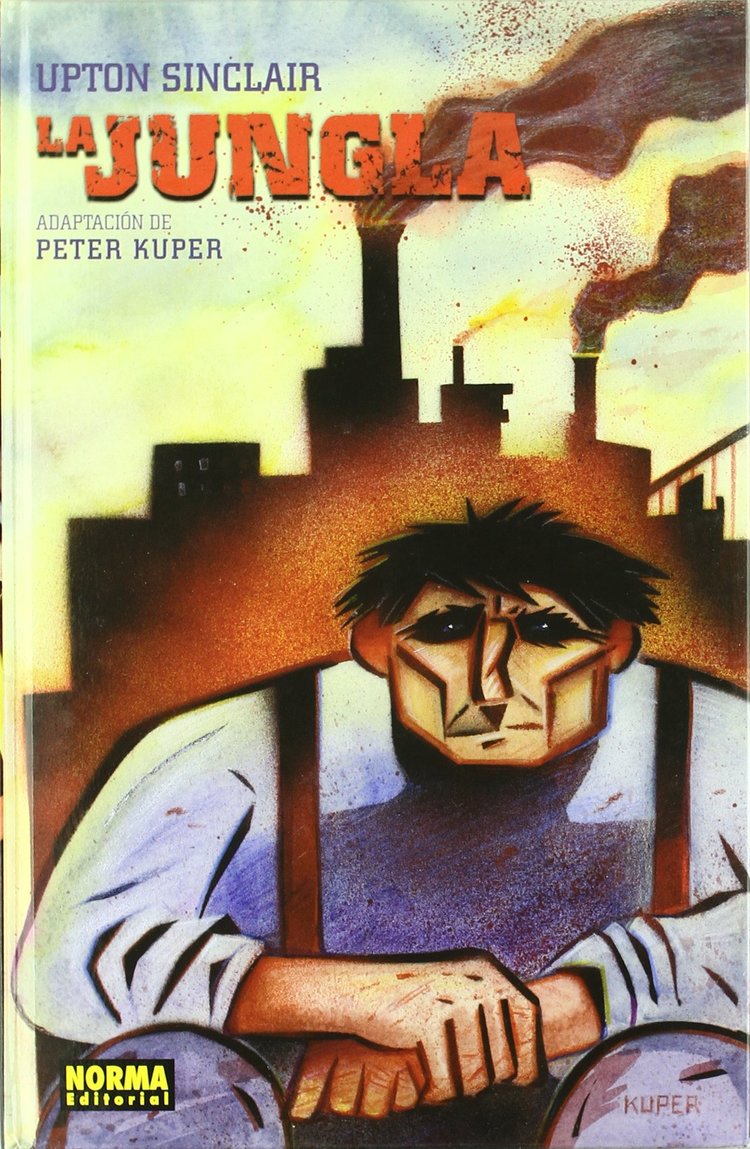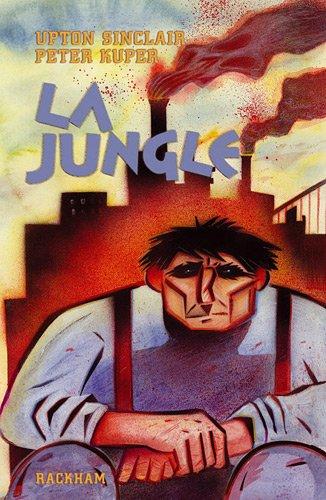The Jungle
Peter Kupers Classics Illustrated adaptation of Upton Sinclair's classic whistle-blowing novel on the conditions at the Chicago slaughter houses in the early 20th century is brought back to press in a beautiful larger size hardcover. One of his best and most poignant works.
Comics Lit // Hardcover // Sept 2004 // ISBN 1561634042
8 x 0.5 x 12 inches / 48 pages
Available from a variety of booksellers:
International Editions:
Editorial Reviews
From Publishers Weekly
Starred Review. Originally published in 1991 as part of a short-lived revival of the Classics Illustrated line, this adaptation of Sinclair's muckraking socialist novel succeeds because of its powerful images. When Kuper initially drew it, he was already a well-known left-wing comics artist. His unenviable task is condensing a 400-page novel into a mere 48 pages, and, inevitably, much of the narrative drama is lost. Kuper replaces it, however, with unmatched pictorial drama. The story follows Lithuanian immigrant Jurgis Rudkis and his family as they are eaten up and spit out by capitalism (represented by Chicago's packing houses). Kuper uses an innovative full-color stencil technique with the immediacy of graffiti to give Sinclair's story new life. When Jurgis is jailed for beating the rich rapist Connor, a series of panels suffused with a dull, red glow draw readers closer and closer to Jurgis's face, until they see that the glint in his eye is fire. Jurgis, briefly prosperous as a strong-arm man for the Democratic machine, smokes a cigar; the smoke forms an image of his dead son and evicted family. Perhaps most visually dazzling is the cubist riot as strikers battle police amid escaping cattle. Kuper infuses this 1906 novel with the energy of 1980s-era street art and with his own profoundly original graphic innovation, making it a classic in its own right.
Copyright © Reed Business Information, a division of Reed Elsevier Inc. All rights reserved.
From School Library Journal
Grade 10 Up–In 1906, Sinclair published The Jungle, a realistic and scathing portrayal of the life of an immigrant worker. Kuper's revised adaptation focuses solely on its hero, Jurgis Rudkus. Readers follow him from his emigration from Lithuania to downtown Chicago, eager to find the American Dream he's heard so much about. But the harsh world of Chi-town quickly shatters his hopes; forced to take a job at a slaughterhouse, he performs the most menial and vile tasks. An injury pushes him to unemployment and, unable to provide for them, he leaves his family in shame. Rudkus transforms from a starry-eyed dreamer into a cynical but valiant man who fights for workers' rights. Kuper's artwork effectively mimics some of the major art movements of the day. The book opens in a Chagall-inflected form of cubism, lending a folksy, dreamy, and hopeful quality to the early pages. Then, the visuals become increasingly jagged and frenetic until they reach the Futurist-inspired panels that illustrate the story's climax. Well-plotted and beautifully illustrated, Kuper's adaptation breathes new life into this classic American story.–Matthew L. Moffett, Northern Virginia Community College, Annandale
From Booklist
The biographical sketch at the end of Kuper's visualization of the most famous muckraking novel says that it was intended not as an expose of the meatpacking industry but as a pitch for socialism. Kuper and coadapter Russell restore Sinclair's original intent by concentrating on the odyssey, from green Lithuanian immigrant to horribly saddened but finally wiser nascent Socialist Party member, of the book's protagonist, Jurgis Rudkus. It is a story of the highest possible pathos. Jurgis is a working-class Job and worse, for he loses almost everyone he loves to the grinding jaws of industrial capitalism (the coup de grace comes when his dead wife's little brother is eaten by rats) and becomes a strikebreaker and ward heeler before he absolutely bottoms out. Grimmer than Dickens' books, Sinclair's agitprop classic seems tailor-made for Kuper's spectacular color artwork, in which Chagall's buoyant Old World fantasias meet the intense expressionism of Munch and, above all, the cubist-derived constructivism of early Soviet poster art, with a smidgen or two of 1920s German cinema in the compositions. Magnificent. Ray Olson
Copyright © American Library Association. All rights reserved






